Jasper Lake Fanless Showdown: ECS LIVA Z3 and ZOTAC ZBOX CI331 nano UCFF PCs Review
by Ganesh T S on July 8, 2022 8:30 AM EST- Posted in
- Systems
- ZOTAC
- Fanless
- ECS
- Passive Cooling
- UCFF
- Mini-PC
- Jasper Lake
GPU Performance
In moving from Gemini Lake to Jasper Lake, the integrated GPU didn't get as much attention as the CPU did. While retaining the same microarchitecture, the shift to 10nm allowed for integrating more execution units and slight improvements in the maximum clocks. The systems we are looking at today come with different variants of the same GPU microarchitecture:
- Intel June Canyon and ECS LIVA Z2 (Gemini Lake): 18EU @ 750 MHz
- ECS LIVA Z3 / JSLM-MINI (Jasper Lake): 32EU @ 850 MHz
- ZOTAC ZBOX CI331 nano (Jasper Lake): 24EU @ 850 MHz
Based on these specifications alone, we expect the JSLM-MINI / LIVA Z3 to handily best the other systems in GPU performance. However, there are a few caveats to consider:
- Power budget / PL1 limit is higher for the ZBOX CI331 nano compared to the JSLM-MINI
- The June Canyon NUC is actively cooled and is not affected by thermal throttling
- The LIVA Z3 and JSLM-MINI operate with DDR4-2666 SODIMMs, while the ZBOX operates with DDR4-2933 SODIMMs
Keeping these aspects in mind, the GPU performance has to be evaluated in the context of each workload. We put the systems through some standard 3D workloads to get an idea of what they have to offer for GPU-intensive tasks.
GFXBench
The DirectX 12-based GFXBench tests from Kishonti are cross-platform, and available all the way down to smartphones. As such, they are not very taxing for discrete GPUs and modern integrated GPUs. We processed the offscreen versions of the 'Aztec Ruins' benchmark.
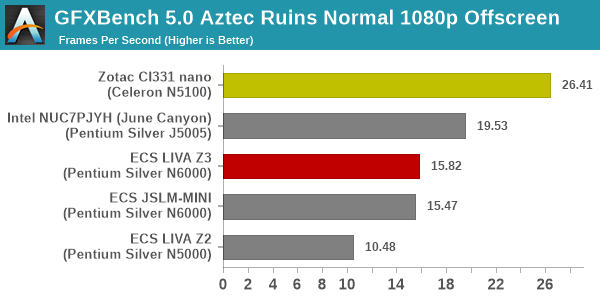
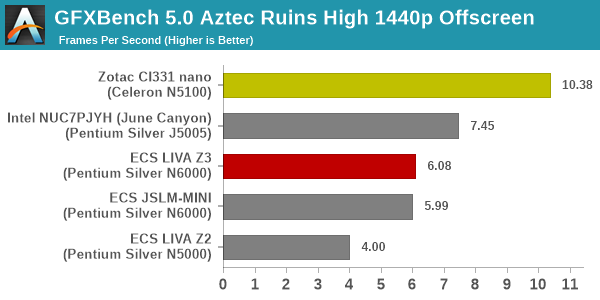
The ZBOX CI331 nano's iGPU has extra EUs compared to the June Canyon NUC. It also has faster RAM access. Though the number of EUs is lesser than the iGPU's in the LIVA Z3 / JSLM-MINI, the higher PL1 limit and faster RAM access help the ZBOX to emerge as the leader in both GFXBench workloads.
UL 3DMark
Four different workload sets were processed in 3DMark - Fire Strike, Time Spy, Night Raid, and Wild Life.
3DMark Fire Strike
The Fire Strike benchmark has three workloads. The base version is meant for high-performance gaming PCs. It uses DirectX 11 (feature level 11) to render frames at 1920 x 1080. The Extreme version targets 1440p gaming requirements, while the Ultra version targets 4K gaming system, and renders at 3840 x 2160. The graph below presents the overall score for the Fire Strike Extreme and Fire Strike Ultra benchmark across all the systems that are being compared.
| UL 3DMark - Fire Strike Workloads | |||
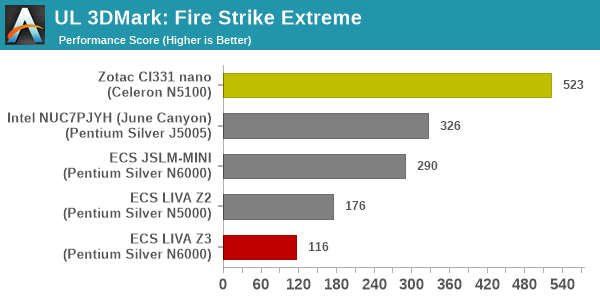
The Extreme workload sees the CI331 nano come out comfortably on top for the same reasons as the ones discussed in the GFXBench subsection - the higher PL1 limits, extra EUs compared to June Canyon, and faster DRAM. The Ultra workload (which doesn't make much sense for UCFF PCs based on low-power processors like Jasper Lake anyway) sees both the LIVA Z3 and the ZBOX CI331 nano get timed out - in all probability due to thermal throttling.
3DMark Time Spy
The Time Spy workload has two levels with different complexities. Both use DirectX 12 (feature level 11). However, the plain version targets high-performance gaming PCs with a 2560 x 1440 render resolution, while the Extreme version renders at 3840 x 2160 resolution. The graphs below present both numbers for all the systems that are being compared in this review.
| UL 3DMark - Time Spy Workloads | |||
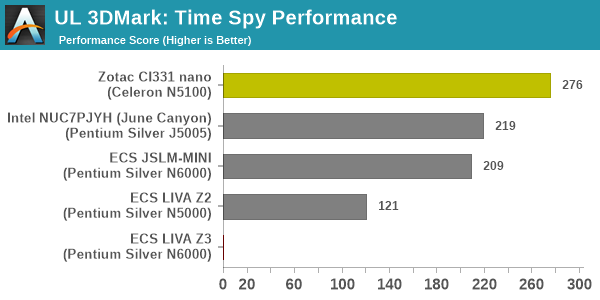
The LIVA Z3 is thermally limited to the extent that neither Time Spy workload completes. The extra EUs and faster RAM help the ZBOX in the normal Time Spy workload. However, at higher resolutions (Extreme), the ZBOX gets thermally limited and its lowered power budget is insufficient to see it get past the June Canyon and JSLM-MINI.
3DMark Wild Life
The Wild Life workload was initially introduced as a cross-platform GPU benchmark in 2020. It renders at a 2560 x 1440 resolution using Vulkan 1.1 APIs on Windows. It is a relatively short-running test, reflective of mobile GPU usage. In mid-2021, UL released the Wild Life Extreme workload that was a more demanding version that renders at 3840 x 2160 and runs for a much longer duration reflective of typical desktop gaming usage.
| UL 3DMark - Wild Life Workloads | |||
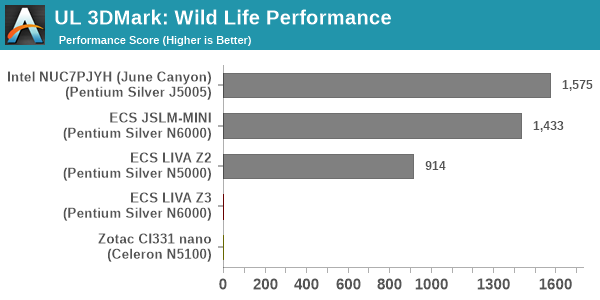
The Wild Life workload was again a mixed bag for the ZBOX, with thermal behavior causing timeouts. The LIVA Z3 failed in both components. Active cooling and a consistent power budget actually see the Gemini Lake-based June Canyon NUC on the leaderboard this time.
3DMark Night Raid
The Night Raid workload is a DirectX 12 benchmark test. It is less demanding than Time Spy, and is optimized for integrated graphics. The graph below presents the overall score in this workload for different system configurations.
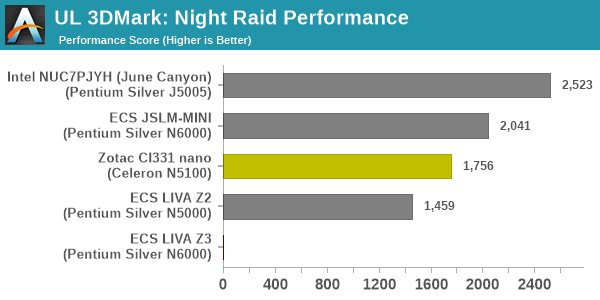
Power budget seems to be the primary factor for the Night Raid workload. The June Canyon NUC is at the top despite its limited EUs and slower RAM. The JSLM-MINI is able to sustain a 6W PL1 for extended durations, and coupled with the extra EUs over the CI331 nano, it handily bests the ZBOX in this workload.










52 Comments
View All Comments
IntelUser2000 - Saturday, July 9, 2022 - link
I hope Alderlake-N gets a SoC variant of the 10nm process unlike the HP process for regular Alderlake.nandnandnand - Saturday, July 9, 2022 - link
It will be a shrink from 10nm to Intel 7 (formerly 10nm Enhanced SuperFin), and they should have different cell libraries available. I think they'd want the densest one. I'm sure whatever it becomes will be impressive compared to Jasper Lake.More importantly, I hope we see a lot of the 8-cores.
Thala - Tuesday, July 12, 2022 - link
Of course 8cx devices are more premium. But I was not referring to price, but to what it is technically possible within a 7W power envelope if you include devices, which does not contain Intel CPUs. It just shows that Intel CPUs are incredibly power inefficient independent of price. This includes Lakefield, Jasperlake or whatever CPU Intel designed for the sub 9W TDP market.IntelUser2000 - Saturday, July 9, 2022 - link
In MT yes. It's still quite a bit faster in ST.In ST if not under emulation both CPUs are roughly comparable.
mode_13h - Sunday, July 10, 2022 - link
Ganesh & Ryan:Above, we were talking about how Jasper Lake compares with Skylake and ARM A76 cores. It would be fantastic to have some hard data on this. Why not run SPEC bench on these mini PCs? It can't be any less weird than running it on a iPhone, right?
mode_13h - Sunday, July 10, 2022 - link
Oops, meant to say: "... can't be any weirder than running it on an iPhone"PeachNCream - Sunday, July 10, 2022 - link
A few typos here and there but a good review of hardware that might, for once, realistically land on someone's desk these days. Pity about the Liva's cooling situation. I wonder if chopping open a fair amount of the case top and replacing it with a fan grille or an epoxy-attached bit of non-metallic screen would be sufficient to mitigate the cooling problems while still retaining the bulk of the case itself. Too bad ECS didn't do potential buyers any justice with this design since the cost is otherwise okay.abufrejoval - Monday, July 11, 2022 - link
I can’t help but wonder if Anandtech feels a certain affinity to near-death technology these days…Jasper Lake is unfortunately dead. Whatever is being sold, was manufactured long ago and these systems are the typical leftover stock that Intel is pushing out the back door, as it reduces internal stockpiles to cover long-term warranties: nearly rock bottom, in other words.
I’ve been using Atoms since the J1900 on ASRock Mini-ITX boards, that were 100% passive, simply because they were 100% passive and thus zero noise: a somewhat novel experience ever since I switched from an Apple ][ [clone] to an IBM-AT [clone], which unfortunately started the trend on noisily moving parts.
And one constant has been, that Atoms have always supported way more RAM than advertised. It was 16GB or DDR3 on the DDR3 Atoms, 32GB for the J5005 devices I’ve been running as a oVirt(RHEV) cluster for a couple of years now.
A couple of weeks ago a Jasper Lake or Atlas Canyon NUC11 (NUC11ATKPE) popped up on my radar and since I’d been on a constant lookout for them, I immediately grabbed one, only to see that it might have been both, the first and last gasp of a phantom device: it’s been unavailable since, just as it was for it’s entire official life-time before.
And after putting it through its paces that is quite sad, because it really is a rather strappy and solid little machine, especially at a 2x Raspberry PI4 price point. It performs near identical to a Sandy Bridge i7-2600 and beats the Pi into a pulp with only a tiny helping of extra Watts: 10 vs 28nm does make a difference!
And again, just as you noticed, Jasper Lake will run just fine with far more RAM than Intel wants you to know. That is a constant with every NUC I’ve owned, i7 based NUC8/10/11 all run with 64GB just fine, even if only the Tiger Lake, from which I borrowed the dual 32GB DDR4-3200 SO-DIMMs for the Jasper Lake evaluation, did so officially.
But where my Tiger Lake will squeeze 40GB/s from that RAM, Jasper Lake will only get 25GB/s: quite a bit better than earlier Atoms, which rarely reached 10GB/s no matter what you gave them, dual-channel or not. The biggest benefit is for the iGPU, which probably won’t run Quake well enough, but does fairly well on a 4k desktop at 60Hz: the Chrome 3D Globe View render never ceases to amaze me in terms of what level of 3D interactivity is possible if the code isn’t Microsoft’s Flight Simulator. I haven't really checked, but I'd feel confident to say that it's iGPU performance is similar to the NUC10's Comet Lake UHD, which only has 24EUs but runs at roughly twice the speed. I can't go near the Tiger Lake, but none are meant for gaming.
The NUC has a fan. It’s practically noiseless and even a Prime95/FurMark combo won’t turn it into a howler, but it’s something that can clog and fail eventually. I’d have preferred another fully passive Mini-ITX from ASRock, but that was not to be. Rumor has it, OEMs quite simply refused to take Jasper Lake Atoms from Intel, even at typical contra-revenue bundle deals (effectively for free). Evidently they were stock poison, but I'd love to hear from anyone who knows more.
The Intel NUC is quite extraordinary in that it sports a front USB2 pin-grid connector covered by a rubber cap, that hints a very large signage customer OEM deal as the sole reason for its existence.
It certainly should have been given a 2.5Gbit/s Ethernet port (likely $1 extra cost), but then 1GB Ethernet simply should no longer be sold anywhere today. It also lacks SATA support, which is a bit of a bummer for someone like me, who still has quite a few SATA SSDs on hand, but a very logical choice otherwise.
But note that only two PCIe lanes are available for NVMe use, at least they are 3.0 this time, where all earlier Atoms topped out with 2.0 speeds on PCIe. The two rear USB3 ports are supposed to support 10Gbit/s, not quite Thunderbolt but please consider the TDP levels available.
The NUC chassis otherwise is extremely impressive for this price range, it feels extremely solid and built to last the 10 years perhaps expected from a digital signage device.
It seems a rather competent micro-server device and I'd thoroughly recommend it, if it was a live product. Too bad it’s dead, all you see is left-overs and there is no successor in sight.
nandnandnand - Tuesday, July 12, 2022 - link
Jasper Lake stock is being pushed out... at prices that you may actually want to buy it at. Actually, the older Gemini Lake Refresh is still being sold, in sub-$100 N4020 laptops for example.The RAM thing is weird. I recall some of the ARK pages lying about the amount of RAM supported on certain Atom models. Like saying 8 GB maximum instead of 32 GB.
The rumor mill has pointed to Alder Lake-N being the upcoming successor to Jasper Lake, with the headline change being a doubling to 8 cores. Presumably, dual-core would be gone for good and the cheapest models would become quad-cores.
There's also the embedded/enterprise-focused Elkhart Lake counterpart to Jasper Lake.
mode_13h - Wednesday, July 13, 2022 - link
BTW, Elkhart Lake supports in-band ECC, which means it doesn't limit the customer in their selection of RAM. However, it does come at a slight cost in performance and memory capacity.Too bad all the Elkhart Lake boards I see are rather pricey.
Getting back to ECC, you'd have to move to Atom C-series or P-series to get a SoC with these cores and full ECC support. See links in my post, above.